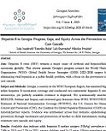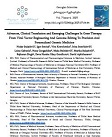Scenarios of fire behavior using physical models of tunnels with different inclinations
Downloads
Critical velocity remains one of the most important design parameters in the theory and practice of emergency ventilation of road tunnels. It should be noted that basing practice only on this value can lead to serious error. Therefore, it is necessary to take into account other important parameters of a particular tunnel and to develop in advance a clear algorithm of actions to manage emergencies. In this paper, numerical and physical models are used to investigate the scenarios of fire development of different strengths. The nature of the expected aerodynamic resistance in the tunnel caused by fire is analyzed. In particular, the reduction of ventilation velocity caused by the throttle effect and the algebraic summation of flows are distinguished from each other. Fires are simulated in a stainless metal sheet tunnel model in a laboratory setting, taking into account the critical Froude number, and the nature of the backlayering length variation depending on the tunnel slope is illustrated. The paper shows that the fire not only practically “reduces” the tunnel cross-section, but also causes additional traction due to the change in the density of the air mixture, which acts against the fan in the case of downward ventilation. It is also demonstrated that in inclined tunnels, in case of deactivated ventilation, when only natural traction acts during the fire, it is possible to reliably determine the numerical value of the critical ventilation velocity.
Downloads
"Questions and Answers: The revision of the TEN-T Regulation". Strasbourg. 14 December 2021.
Bird A., Carvel R. Handbook of Tunnel Fire Safety. Second edition. Thomas Telford Limited, 2012, p. 694.
FIT - Thematic Network FIT ‘Fire in Tunnels’ is supported by the European Community under the fifth Framework Program ‘Competitive and Sustainable Growth’ Contract n° G1RT-CT-2006, p. 76.
UN, Economic and Social Council, Economic Commission for Europe, Report TRANS/AC.7/9, 2001, p. 60.
UN, Economic and Social Council, Economic Commission for Europe, Report TRANS/AC.7/9, 8 February 2002, p. 6.
UN, Economic and Social Council, Economic Commission for Europe, Report TRANS/AC.7/15, 2004, p. 7.
UN, Economic and Social Council, Economic Commission for Europe, Report TRANS/AC.7/11, 2002, p. 6.
The White Book 2001, Published in April 24, 2001, Sweet & Maxwell Ltd, ISBN 10: 0421745800, ISBN 13:9780421745803.
Haack. A. Fire Protection in Traffic Tunnels: General Aspects and Results of the EUREKA Project, TUNNELING AND UNDERGROUND SPACE TECHNOLOGY, 1998, Volume 13, № 2, pp. 377-381.
Li Y.Z., Vylund L., Ingason H., Appel G. Influence of fire suppression on combustion products in tunnel fires. The work Co-financed by the European Union. Report 2015, p. 70.
Lanchava O., Javakhishvili G. Impact of strong fires on a road tunnel ventilation system. Bulletin of the Georgian National Academy of Sciences 15 (4), 2021, pp. 38-45.
Lanchava O.A. Hygroscopic heat and mass transfer in underground structures. GTU, 1998, Tbilisi, p. 272.
Lanchava O., Ilias N., Radu S.M., Nozadze G., Jangidze M. PREVENTING THE SPREAD OF COMBUSTIBLE PRODUCTS IN TUNNELS BY IMPLEMENTING A DIVISIBLE SYSTEM. Environmental Engineering & Management Journal (EEMJ) 21 (4), 2022.
Lanchava O., Ilias N. Complex calculation method of temperature, mass transfer potential and relative humidity for ventilation flow in subway. Journal of Engineering Sciences and Innovation, 2018, 3 (1), pp. 69-84.
Vaitkevicius A., Carvel R. Investigating the Throttling Effect in Tunnel Fires. Fire Technology, Vol. 52, 2016, pp. 1619–1628.
Li Y.Z., Ingason H. Discussions on critical velocity and critical Froude number for smoke control in tunnels with longitudinal ventilation. Fire Safety Journal, Vol. 99, 2018, pp. 22-26.
Lanchava O., Bezhanishvili A., Javakhishvili G., Khokerashvili Z., Arudashvili N. Study of the throttling effect in tunnel fires. Inżynieria Mineralna 1 (1), 2024, pp. 385–393. https://doi.org/10.29227/IM-2024-01-44
Lanchava O., Nozadze G., Bochorishvili N., Lebanidze Z., Arudashvili N., Jangidze M., Tsikarishvili K. Criteria for evaluation of emergency firefighting in transport tunnels. Transport Bridge Europe-Asia, Proceedings of conference, Tbilisi, 2014, pp. 29-35.
Lanchava O., Abashidze G., Tsverava D. Securing fire safety for underground structures. Quality-Access to Success, 2017, 18.
Lanchava O., Ilias N., Nozadze G., Radu S., Andras I., Moraru R. Developing of Wi-Fi monitoring control systems for damage factors of fire in road tunnels. The XIth Edition of the Annual Conference “The Academic Days of Technical Sciences Academy of Romania”, 2016.
Lanchava O., Ilias N., Nozadze G. Some problems for assessment of fire in road tunnels. Supplement of Quality-Access to Success: Bucharest, Vol. 18, (S1), 2017, pp. 69-72.
Lanchava O., Ilias N. Some issues of thermal calculation of ventilation air for the metro. Journal of Engineering Sciences and Innovation 12, 2017, pp. 92-105.
Lanchava O., Ilias N. Critical velocity analysis for safety management in case of tunnel fire. MATEC Web of Conferences 305, 00023, 2020.
Li Y.Z., Lei B., Ingason H. Study of critical velocity and backlayering length in longitudinally ventilated tunnel fires. Fire Safety Journal, Vol. 45, 2010, pp. 361-370.
Thomas P.H. The Movement of Smoke in Horizontal Passages against an Air Flow. Fire Research Station. Boreham Wood. 1968.
Lee C.K., Chaiken R.F., Singer J.M., Interaction between duct fires and ventilation flow: an experimental study. COMBUSTION SCIENCE AND TECHNOLOGY. Vol. 20, 1979, pp. 59-72.
Danziger N.H., Kennedy W.D. Longitudinal ventilation analysis for the Glenwood canyon tunnels. Fourth International Symposium on the Aerodynamics & Ventilation of Vehicle Tunnels, BHRA Fluid Engineering. 1982.
Kennedy W.D. Critical velocity: past, present and future. Seminar of Smoke and Critical Velocity in Tunnels, JFL Lowndes, 1996, pp. 305–322.
Copyright (c) 2024 Georgian Scientists

This work is licensed under a Creative Commons Attribution-NonCommercial-NoDerivatives 4.0 International License.










































































































































































































